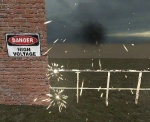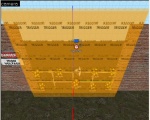WiseElec: Electrified Obstacles

You can upload screenshots at Special:Upload. For help, see the Help:Images.
This tutorial was originally created by wisemx. It was originally posted on SDKnuts.net.
Introduction
In this tutorial, we will create an obstacle such as a fence, in which it is electrified and can be toggled by a trigger. You can any as one but as a recommendation, using a model prop for this makes it easy. For the tutorial we will use a railing from Half-Life 2 (see right).
For the purpose of this tutorial the rail obstacle is initially electrified, since that is what many will require. For that purpose, the example map shows that it can be disabled by standing on a small red carpet and re-enabled by standing on a small green carpet (the carpets are not shown in screenshots).
When a player "touches" the fence in this tutorial while it is electrified there will be sparks, and the player will get blown back a few feet.
trigger_hurt is used to start off the series of events when the player touches it. Additionally, it outputs to entities to create the "blow back" of the player and sparks. These are: one env_physexplosion, eight env_sparks, one trigger_push, and one logic_timer to lend some logic.
It is recommended that you have basic understanding of the Hammer editor, and with placing a entity and the manipulation of such.
Creation
So let's get going on creating that electrified obstacle.
First, we should find a spot in our level or map in which we think we should place one. As with Half-Life 2 players solve "puzzles" to continue progressing the game - and this can be thought as of such.
Next, we will make the obstacle that will be "electrified". This can be a prop_static or a displacement. It is recommended to use something like a fence, or a railing (shown in the first screenshot), since it logical item to a player. You could just as easily use motion enabled entity types. Remember the player has to get around the obstacle.
Now, we will create the entities for the electrified fence.
Most people will require a way of shutting the "electricity" off to the obstacle. Follow these steps:

